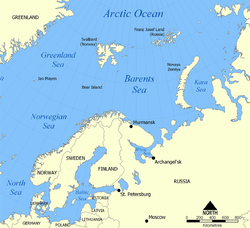| Arctic naval operations of World War II | |||||||
|---|---|---|---|---|---|---|---|
| Part of the European Theater and the Battle of the Atlantic of World War II | |||||||
 Map of the area of greatest naval activity. | |||||||
| |||||||
| Belligerents | |||||||
|
|
| ||||||
| Commanders and leaders | |||||||
|
|
| ||||||
Arctic naval operations of World War II were the World War II naval operations that took place in the Arctic Ocean, and can be considered part of the Battle of the Atlantic and/or of the European Theatre of World War II.[1][note 1]
Pre-war navigation in the region focused on fishing and the international ore-trade from Narvik and Petsamo. Soviet settlements along the coast and rivers of the Barents Sea and Kara Sea relied upon summer coastal shipping for supplies from railheads at Arkhangelsk and Murmansk. The Soviet Union extended the Northern Sea Route past the Taymyr Peninsula to the Bering Strait in 1935.[2] The Winter War of 1939-1940 between Finland and the Soviet Union opened[3] the northern flank of the Eastern Front of World War II. The Arctic[note 2] was initially dominated by the Soviet Northern Fleet of a few destroyers, with larger numbers of submarines, minesweepers, and torpedo cutters supported by icebreakers. The success of the 1940 German invasion of Norway provided the Kriegsmarine with naval bases from which capital ships might challenge units of the British Royal Navy Home Fleet. Luftwaffe anti-shipping aircraft of Kampfgeschwader 26 (KG 26) and Kampfgeschwader 30 (KG 30) operated intermittently from Norwegian airfields, while Küstenfliegergruppen aircraft including Heinkel He 115s and Blohm & Voss BV 138s undertook routine reconnaissance.[4] Following the 1941 Axis invasion of the Soviet Union, the Allies initiated a series of Arctic convoys to bring military supplies to the Soviet Union in formations of freighters screened by destroyers, corvettes and minesweepers. Escorting cruisers typically maneuvered outside the formations, while a larger covering force including battleships and aircraft carriers often steamed nearby to engage Kriegsmarine capital ships or to raid the German naval bases in Norway.
The Soviet Union and Germany each deployed smaller coastal convoys: to maintain the flow of supplies to the Soviet Arctic coast, to transport strategic metal ores from Scandinavia to Germany, and to sustain troops on the northern flank of the Eastern Front. Soviet convoys hugged the coast to avoid ice, while German convoys used fjords to evade Royal Navy patrols. Both sides engaged in minelaying and minesweeping of these shallow, confined routes – vulnerable to mine warfare and to submarine ambushes. Minesweepers and submarine chasers typically screened German convoys, while Soviet convoys were often protected by minesweeping trawlers and torpedo cutters.[5]
A branch of the Pacific Route began carrying Lend-Lease goods through the Bering Strait to the Soviet Arctic coast in June 1942. The number of westbound cargo-ship voyages along this route was 23 in 1942, 32 in 1943, 34 in 1944 and 31 after Germany surrendered in May 1945. Westbound tonnage through the Bering Strait totaled approximately 10% of North American wartime goods sent to Soviet Arctic ports.[6] A large portion of tonnage though the Bering Strait was fuel for Siberian airfields on the Alaska-Siberia air route.[7]
- ^ Kher, Aparna. "What Is Midnight Sun or Polar Day?". timeanddate.com. Retrieved 18 April 2020.
- ^ Drent, Jan Commercial Shipping on the Northern Sea Route p. 4
- ^ Citino, Robert. "White Death". The National WWII Museum. Retrieved 18 April 2020.
- ^ Wood & Gunston pp. 64–75
- ^ Suggs, Robert C. (1986). "Soviet Subs in Scandinavia: 1930 to 1945". Proceedings. 112 (3). United States Naval Institute: 100–106.
- ^ Vail Motter pp. 481–482
- ^ "Arming the Soviets". Columbia Magazine. Archived from the original on 16 April 2013. Retrieved 13 July 2012.
Cite error: There are <ref group=note> tags on this page, but the references will not show without a {{reflist|group=note}} template (see the help page).